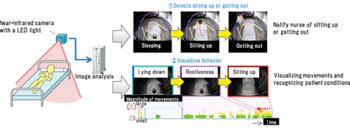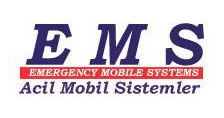Video Analytics Helps Monitor Bedridden Patients
|
By HospiMedica International staff writers Posted on 04 Jun 2014 |

Image: Video technology recognizes patient status (Photo courtesy Fujitsu Laboratories).
New technology uses a video camera to accurately recognize the status of hospital patients, detecting activities such as sitting up in bed, getting out of bed, or moving in bed.
Developed by Fujitsu Laboratories (Kawasaki, Japan), the technology is based on two modalities. The first recognizes the patient's head and tracks it to identify when the patient sits up or gets out of bed, which can be precursors to actions such as wandering, slipping, or falling. The second detects and visualizes conditions such as restiveness or sleeplessness, which demand further attention. The state of the patient in bed is then classified into five categories depending on posture, and defines a state-transition diagram that relates them to each other.
The recognition process also uses learned data, wherein next likely states are limited by the current state, based on the state-transition diagram. Selecting learned data in the recognition process aids in highly accurate patient head position state. But even with the selection of learned data based on patient status, the potential remains to incorrectly recognize pillows as heads. To correct for that, the technology observes points that will always move when the patient sits up or stands up, and will identify multiple regions in the image that might be the head to confirm if it really is the patient's head, or not.
With the cooperation of Tamagawa Hospital (Tokyo, Japan), Fujitsu Laboratories conducted a field trial to test sensing of sitting up and getting out of bed on several patients. The visualization of patient behaviors was found to perform with 91% accuracy. Behaviors demanding attention were displayed at the nursing station, allowing nurses to easily monitor patient movements without going on rounds, resulting in a high standard of patient protection for the hospital or care facility, while at the same time lightening the workload of the nurses.
Existing techniques to detect when a patient has sat up or gotten out of bed rely on pressure sensors that detect bodyweight; but this approach has some problems. Sometimes patients will intentionally avoid the sensor so that it does not react when they get out of bed. In addition, the sensor cannot distinguish when the patient is turning over while sleeping, or when movements by the nurse are triggering it, resulting in false alarms. And even with the sensors, nurses still need to make frequent checks, and if anything their workload may be higher.
Related Links:
Fujitsu Laboratories
Tamagawa Hospital
Developed by Fujitsu Laboratories (Kawasaki, Japan), the technology is based on two modalities. The first recognizes the patient's head and tracks it to identify when the patient sits up or gets out of bed, which can be precursors to actions such as wandering, slipping, or falling. The second detects and visualizes conditions such as restiveness or sleeplessness, which demand further attention. The state of the patient in bed is then classified into five categories depending on posture, and defines a state-transition diagram that relates them to each other.
The recognition process also uses learned data, wherein next likely states are limited by the current state, based on the state-transition diagram. Selecting learned data in the recognition process aids in highly accurate patient head position state. But even with the selection of learned data based on patient status, the potential remains to incorrectly recognize pillows as heads. To correct for that, the technology observes points that will always move when the patient sits up or stands up, and will identify multiple regions in the image that might be the head to confirm if it really is the patient's head, or not.
With the cooperation of Tamagawa Hospital (Tokyo, Japan), Fujitsu Laboratories conducted a field trial to test sensing of sitting up and getting out of bed on several patients. The visualization of patient behaviors was found to perform with 91% accuracy. Behaviors demanding attention were displayed at the nursing station, allowing nurses to easily monitor patient movements without going on rounds, resulting in a high standard of patient protection for the hospital or care facility, while at the same time lightening the workload of the nurses.
Existing techniques to detect when a patient has sat up or gotten out of bed rely on pressure sensors that detect bodyweight; but this approach has some problems. Sometimes patients will intentionally avoid the sensor so that it does not react when they get out of bed. In addition, the sensor cannot distinguish when the patient is turning over while sleeping, or when movements by the nurse are triggering it, resulting in false alarms. And even with the sensors, nurses still need to make frequent checks, and if anything their workload may be higher.
Related Links:
Fujitsu Laboratories
Tamagawa Hospital
Latest Critical Care News
- CPR Guidelines Updated for Pediatric and Neonatal Emergency Care and Resuscitation
- Ingestible Capsule Monitors Intestinal Inflammation
- Wireless Implantable Sensor Enables Continuous Endoleak Monitoring
- Pulse Oximeter Index Offers Non-Invasive Guides for Fluid Therapy
- Wearable Patch for Early Skin Cancer Detection to Reduce Unnecessary Biopsies
- 'Universal' Kidney to Match Any Blood Type
- Light-Based Technology to Measure Brain Blood Flow Could Diagnose Stroke and TBI
- AI Heart Attack Risk Assessment Tool Outperforms Existing Methods
- Smartphone Imaging System Enables Early Oral Cancer Detection
- Swallowable Pill-Sized Bioprinter Treats GI Tract Injuries

- Personalized Brain “Pacemakers” Could Help Patients with Hard-To-Treat Epilepsy
- Microscopic DNA Flower Robots to Enable Precision Medicine Delivery
- Origami Robots to Deliver Medicine Less Invasively and More Effectively
- Improved Cough-Detection Technology Aids Health Monitoring
- AI Identifies Children in ER Likely to Develop Sepsis Within 48 Hours
- New Radiofrequency Therapy Slows Glioblastoma Growth
Channels
Surgical Techniques
view channel
Robotic Assistant Delivers Ultra-Precision Injections with Rapid Setup Times
Age-related macular degeneration (AMD) is a leading cause of blindness worldwide, affecting nearly 200 million people, a figure expected to rise to 280 million by 2040. Current treatment involves doctors... Read more
Minimally Invasive Endoscopic Surgery Improves Severe Stroke Outcomes
Intracerebral hemorrhage, a type of stroke caused by bleeding deep within the brain, remains one of the most challenging neurological emergencies to treat. Accounting for about 15% of all strokes, it carries... Read morePatient Care
view channel
Revolutionary Automatic IV-Line Flushing Device to Enhance Infusion Care
More than 80% of in-hospital patients receive intravenous (IV) therapy. Every dose of IV medicine delivered in a small volume (<250 mL) infusion bag should be followed by subsequent flushing to ensure... Read more
VR Training Tool Combats Contamination of Portable Medical Equipment
Healthcare-associated infections (HAIs) impact one in every 31 patients, cause nearly 100,000 deaths each year, and cost USD 28.4 billion in direct medical expenses. Notably, up to 75% of these infections... Read more
Portable Biosensor Platform to Reduce Hospital-Acquired Infections
Approximately 4 million patients in the European Union acquire healthcare-associated infections (HAIs) or nosocomial infections each year, with around 37,000 deaths directly resulting from these infections,... Read moreFirst-Of-Its-Kind Portable Germicidal Light Technology Disinfects High-Touch Clinical Surfaces in Seconds
Reducing healthcare-acquired infections (HAIs) remains a pressing issue within global healthcare systems. In the United States alone, 1.7 million patients contract HAIs annually, leading to approximately... Read moreHealth IT
view channel
Printable Molecule-Selective Nanoparticles Enable Mass Production of Wearable Biosensors
The future of medicine is likely to focus on the personalization of healthcare—understanding exactly what an individual requires and delivering the appropriate combination of nutrients, metabolites, and... Read moreBusiness
view channel
Philips and Masimo Partner to Advance Patient Monitoring Measurement Technologies
Royal Philips (Amsterdam, Netherlands) and Masimo (Irvine, California, USA) have renewed their multi-year strategic collaboration, combining Philips’ expertise in patient monitoring with Masimo’s noninvasive... Read more
B. Braun Acquires Digital Microsurgery Company True Digital Surgery
The high-end microsurgery market in neurosurgery, spine, and ENT is undergoing a significant transformation. Traditional analog microscopes are giving way to digital exoscopes, which provide improved visualization,... Read more
CMEF 2025 to Promote Holistic and High-Quality Development of Medical and Health Industry
The 92nd China International Medical Equipment Fair (CMEF 2025) Autumn Exhibition is scheduled to be held from September 26 to 29 at the China Import and Export Fair Complex (Canton Fair Complex) in Guangzhou.... Read more







.jpg)






